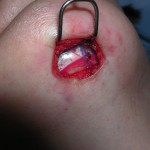A wide variety of synthetic materials have been used in the chin but the standard over time continues to be solid silicone. It is well tolerated, flexible, easy to insert and remove, can be easily manufactured in an endless number of configurations and sizes, and is inexpensive. Its flexibility allows even large extended implants to be placed through small incisions. As of this writing, porous polyethylene (Medpor) is the lone alternative and good results can be achieved with its use although it is more expensive, requires greater intraoperative time and effort for fashioning and placement, and is more difficult to remove should that ever be necessary
.
The chin implant is almost always put in through a small incision on the underside of the chin in the submental crease. This provides a direct approach for placement of the implant (shortest distance to the bone) and allows liposuction and neck tightening procedures to be done through the same incision. The chin implant is slide into position on the bone after a pocket has been made that will accomodate its size. Once in place, it is either sewn or screwed into place and the tissue closed over it. While a chin implant can also be placed through the mouth (a common approach done by many oral surgeons), placing it this way disrupts the main chin muscle and the risk of having the implant riding too high on the chin bone after surgery unless the implant is secured by screws to the bone.

Chin implants are a very safe procedure that has few complications if done well. Infection after surgery is rare but the implant could be salvaged by antibiotics alone if it occurs in the early postoperative period. Thereafter, implant removal is usually required for resolution. Some temporary lower lip numbness can occur but this resolves quite quickly after surgery.
Short chins (both in height and in length) are good indications for what we call alloplastic mentoplasty, otherwise known as a chin augmentation using a synthetic implant. Chin implants are by far and away the most common method for enlarging one’s chin. Its principal advantage is that it is simple and quick to do, allows for a rapid recovery, and the result is very predictable with a high patient satisfaction rate.
Dr. Barry Eppley
Indianapolis, Indiana




